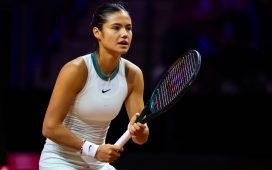Apparently, the US Open men’s final on Sunday night was incredible. I wouldn’t know; I only saw the highlights. Which, as everyone knows, is by far the least satisfying way of watching a tennis match: inferior in many ways to watching nothing. For some reason tennis has always been strangely resistant to the highlights treatment: a game of infinite pivots and infinite crises, where every apparent turning point merely heralds the next, where its most epic passages feel like the world is ending again and again and again. Abridging all this feels somehow wrong, faithless: like trying to sum up Like a Rolling Stone in a pie chart.
Even so, there’s something uniquely maddening to the crude and cloven-hooved indelicacy of Amazon’s highlights packages: a sensation roughly comparable to being told an anecdote by someone who keeps forgetting the key details. Breaks of serve go unseen. Set points lurch at you from nowhere. The gruelling, juddering fifth set between Dominic Thiem and Alexander Zverev was dispensed with almost as an afterthought: Thiem’s first two match points not shown, the third appearing out of thin air.
In a sense, this is the eternal gift and curse of tennis, a sport that reveals its truths slowly: plans gradually revealed and decrypted, chess games within chess games. It wasn’t until I read about it afterwards, for example, that I realised Thiem had been battling debilitating cramps and could barely walk by the end. But it is a reminder, too, that there is both an art and a science to the humble highlights package that feels increasingly crucial in the current landscape: a world of sporting backlog, of ever-swelling viewing options and ever-decreasing attention spans.
Tom Richardson, a digital media lecturer at Columbia University, describes this as the “highlights industrial complex”: a smartphone-led blizzard of instant messaging and gifs and short-form videos that is how most people younger than 40 overwhelmingly consume their sport these days. And so this is a dilemma all sports are grappling with: how to adapt their product to an audience unwilling to sit in front of a television for several hours? And how to condense sport into handy snackable morsels without mislaying its very essence? Clearly, this is simpler for some sports than for others. Football has decades of experience at slicing its games into handy two-minute chunks with a nifty Gerald Sinstadt voiceover. Cricket seems to work over any distance: five days, 11 days, 20 overs, a one-hour highlights programme or a three‑minute video on the BBC website overlaid with lots of lurid colour swatches and random words such as “WOW”, “YASSSS” AND “Y THO”.
Tennis, by contrast, has massive problems in this respect. A three-minute video package might show only around 10-12 points in a match: not enough to say anything about anything. For the same reason, cycling remains stubbornly irreducible: there’s little point showing a sprint finish or a decisive break, for example, if you can’t grasp the hours of painstaking work that set it up. Snooker is nigh-on impossible to abridge. Formula One compresses pretty well. Golf, long conceived as a sport you play to escape modernity rather than embrace it, has literally no idea about any of this.
For sports trying to reanimate shrivelling revenue streams in a rapidly advancing market, these are questions of survival. In a way, highlights are the last umbilical link between a sport and what we so imprecisely describe as the “general public”, the last winnowing middle ground between the obsessive and the apathetic. Insofar as it is even possible to be a “casual fan” of anything any more, short-form video is the only realistic way of doing so.
Nevertheless, it’s worth dwelling on what gets lost in this whole process. After all, as with any form of subjective curation, what we don’t see is just as telling as what we do. Perhaps that consummate central-midfield performance was always destined to fly under the radar. Perhaps the team immaculately controlling the peloton all day never quite got the credit they deserved. But it feels as if these forces are now in acceleration, that sport is increasingly being sold to us not as a battle of wits and will, but of execution and flourish, not as a process but as a series of discrete, arbitrary events.
There are questions, too, for us as consumers. How much sport can we take? And how much of it do we actually want? If there’s an art to compiling highlights, then there was always an art to watching them, too: seeing a player being booked on Match of the Day and realising they would later be getting sent off, the shock of seeing a dot ball on the cricket highlights, and wondering why. Those with Sky Plus or its equivalent will be familiar with the skill of fast-forwarding through a paused football match without missing any of the goalmouth action: a game that in today’s age of rapid vertical football is fraught with dangers.
But even this now feels like the sport of a rapidly vanishing era. This is a culture in which we are now urged to see the part rather than the whole.
Here, some films and music you’ll like. Here, the groceries you buy most often. Here, some news that conforms to your politics. According to research by Microsoft, our average attention span has dropped from 12 to eight seconds since 2000. We’re less patient than we ever were. Some sports will adapt better than others. And if you simply skimmed to the end to find that out, then congratulations: in the scheme of things, you didn’t miss much.








